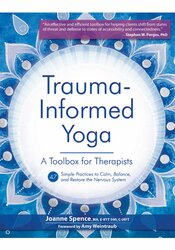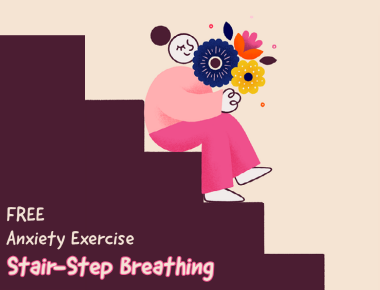Coping Ahead of Anxiety with Stair-Step Breathing

It’s winter here where I live in the northeastern United States. Today it is cold and snowy. I am struck by the quiet that the snow brings with it. Until it turns icy, muddy, or slushy, the blanket of white on the brown landscape is a welcome sight. Still, it can be treacherously slippery out there, and the cold air also brings with it other forms of difficulty. In particular, for people prone to asthma, the cold air can make it notoriously difficult to breathe. I recall that one of my longtime yoga students, who had a history of asthma, once found herself planted face down on the ice—a scary thing even without asthma—and started to panic as her breathing became restricted. She was alone and had left the house without her rescue inhaler. In recounting the incident, she told me, “I knew right then that this was a very dangerous situation, but I did my best to lean in to my yoga practice, and a little voice in the back of my head—that sounded remarkably like you—told me to take a light, long inhale and then let it out. And it worked. There I was, getting colder by the minute, but I was calm and breathing and not gasping for air. I attribute that to my yoga practice.” I was, of course, delighted with this report. While this may not happen to everyone who has asthma, my friend found comfort and, indeed, real relief as a result of her yoga practice.
Similar to the experience of those with asthma, clients often report to me that anxiety can also cause a feeling of restriction in the body or a great feeling of pressure on the chest area. When we experience anxiety in this way, it may well be the beginning of a panic attack—a truly frightening experience where our body goes into a state of fight or flight. In the midst of this sympathetic nervous system activation, it is challenging to learn something new, such as deep breathing techniques. But it is a good time to rely on muscle memory for deep breathing that’s been built from repetitious activity over time—yes, I am referring to practice. If we can learn and practice these skills when we are more relaxed and rested—that is, when our parasympathetic nervous system is online—then we can learn to apply these skills when we need it the most, like when we fall on the ice or have the wherewithal to identify the early stages of a panic attack. Having prepared ourselves with prior practice, we are more likely to be able to use a breathing pattern that will help us switch from sympathetic activation back to parasympathetic activation when necessary.
Here’s one of my go-to practices for reducing anxiety. It is called Stair-Step Breathing.
Similar to the experience of those with asthma, clients often report to me that anxiety can also cause a feeling of restriction in the body or a great feeling of pressure on the chest area. When we experience anxiety in this way, it may well be the beginning of a panic attack—a truly frightening experience where our body goes into a state of fight or flight. In the midst of this sympathetic nervous system activation, it is challenging to learn something new, such as deep breathing techniques. But it is a good time to rely on muscle memory for deep breathing that’s been built from repetitious activity over time—yes, I am referring to practice. If we can learn and practice these skills when we are more relaxed and rested—that is, when our parasympathetic nervous system is online—then we can learn to apply these skills when we need it the most, like when we fall on the ice or have the wherewithal to identify the early stages of a panic attack. Having prepared ourselves with prior practice, we are more likely to be able to use a breathing pattern that will help us switch from sympathetic activation back to parasympathetic activation when necessary.
Here’s one of my go-to practices for reducing anxiety. It is called Stair-Step Breathing.
Sitting or standing up straight, spine tall, chest lifted with feet on the floor.
Take four little sips of air through the nose to make one complete inhalation, imagining that each sip brings you one stair closer to the top of a staircase.
At the top of your breath, pause for a moment.
Now slowly and smoothly exhale your breath through your nose, imagining an elevator descending back to the ground floor.
Repeat three times before returning to your natural breath. Notice how you feel.
Take four little sips of air through the nose to make one complete inhalation, imagining that each sip brings you one stair closer to the top of a staircase.
At the top of your breath, pause for a moment.
Now slowly and smoothly exhale your breath through your nose, imagining an elevator descending back to the ground floor.
Repeat three times before returning to your natural breath. Notice how you feel.
Get insight and interventions like this and more in Joanne’s new book with PESI, Trauma-Informed Yoga: A Toolbox for Therapists: 47 Simple Practices to Calm, Balance, and Restore the Nervous System

Although many forms of trauma treatment rely solely on talk therapy as a means of healing, we cannot “talk out” every issue related to trauma. Indeed, trauma is stored in the body and the brain and must be treated as such.
Designed with both mental health clinicians and clients in mind, Trauma-Informed Yoga offers 47 short, simple practices that regulate the autonomic nervous system, calm the racing mind, and center those of us living chaotic 21st century lives.
Drawing from over 20 years of teaching and clinical practice, Spence masterfully weaves together the ancient wisdom of yoga with modern neuroscience and clinical practice in an accessible and compassionate manner.
This how-to toolbox will arm you with knowledge and with powerful, yet simple, mind-body activities that reduce suffering and increase well-being.
Designed with both mental health clinicians and clients in mind, Trauma-Informed Yoga offers 47 short, simple practices that regulate the autonomic nervous system, calm the racing mind, and center those of us living chaotic 21st century lives.
Drawing from over 20 years of teaching and clinical practice, Spence masterfully weaves together the ancient wisdom of yoga with modern neuroscience and clinical practice in an accessible and compassionate manner.
This how-to toolbox will arm you with knowledge and with powerful, yet simple, mind-body activities that reduce suffering and increase well-being.
Meet the Experts:
Joanne Spence, MA, E-RYT 500, C-IAYT, is a recovering social worker and certified yoga therapist. She is the founder and executive director of Yoga in Schools. Joanne trains and teaches all sorts of amazing people, both nationally and internationally, in yoga. She has taught yoga in prisons, hospitals, schools, churches, and sometimes on street corners. She specializes in working with adults and children who are experiencing chronic pain, trauma, depression, anxiety, ADHD, and insomnia.
Learn more about their educational products, including upcoming live seminars, by clicking here.
Learn more about their educational products, including upcoming live seminars, by clicking here.



